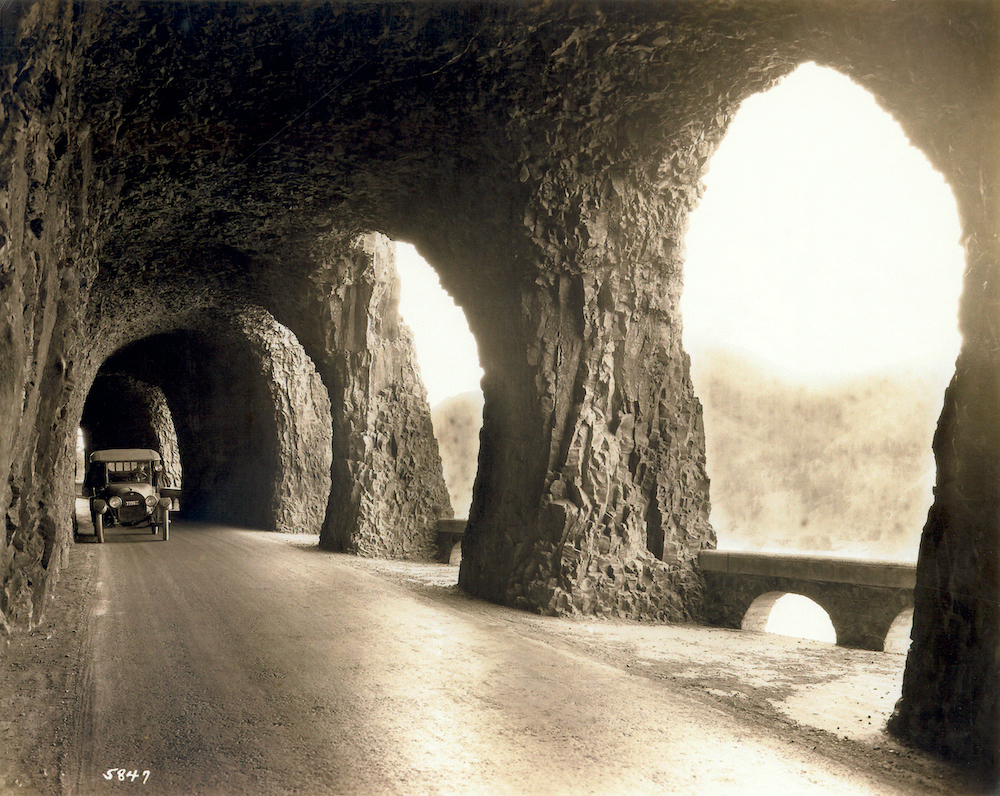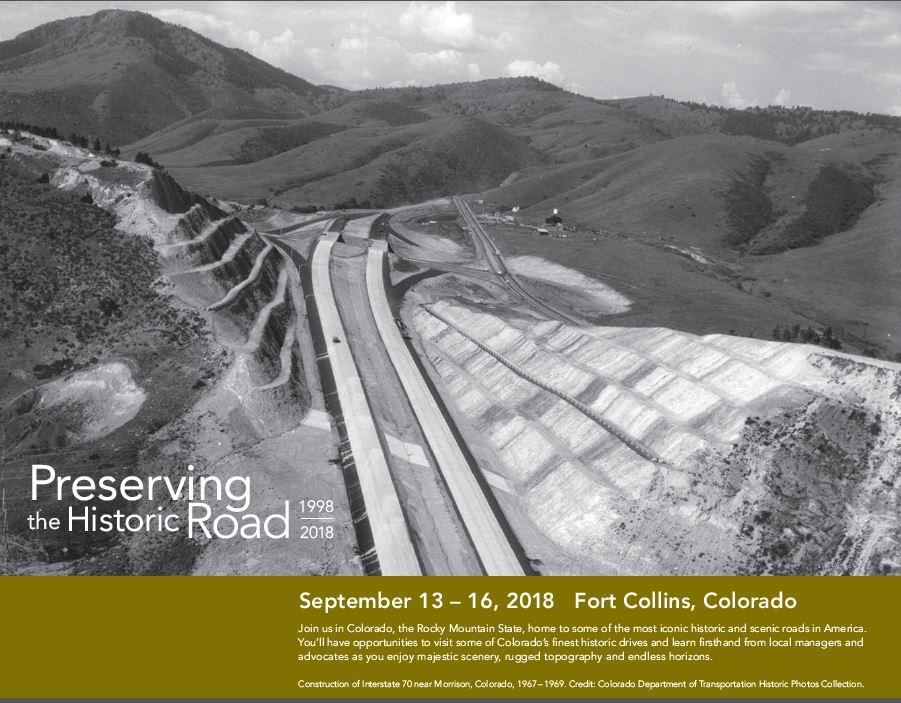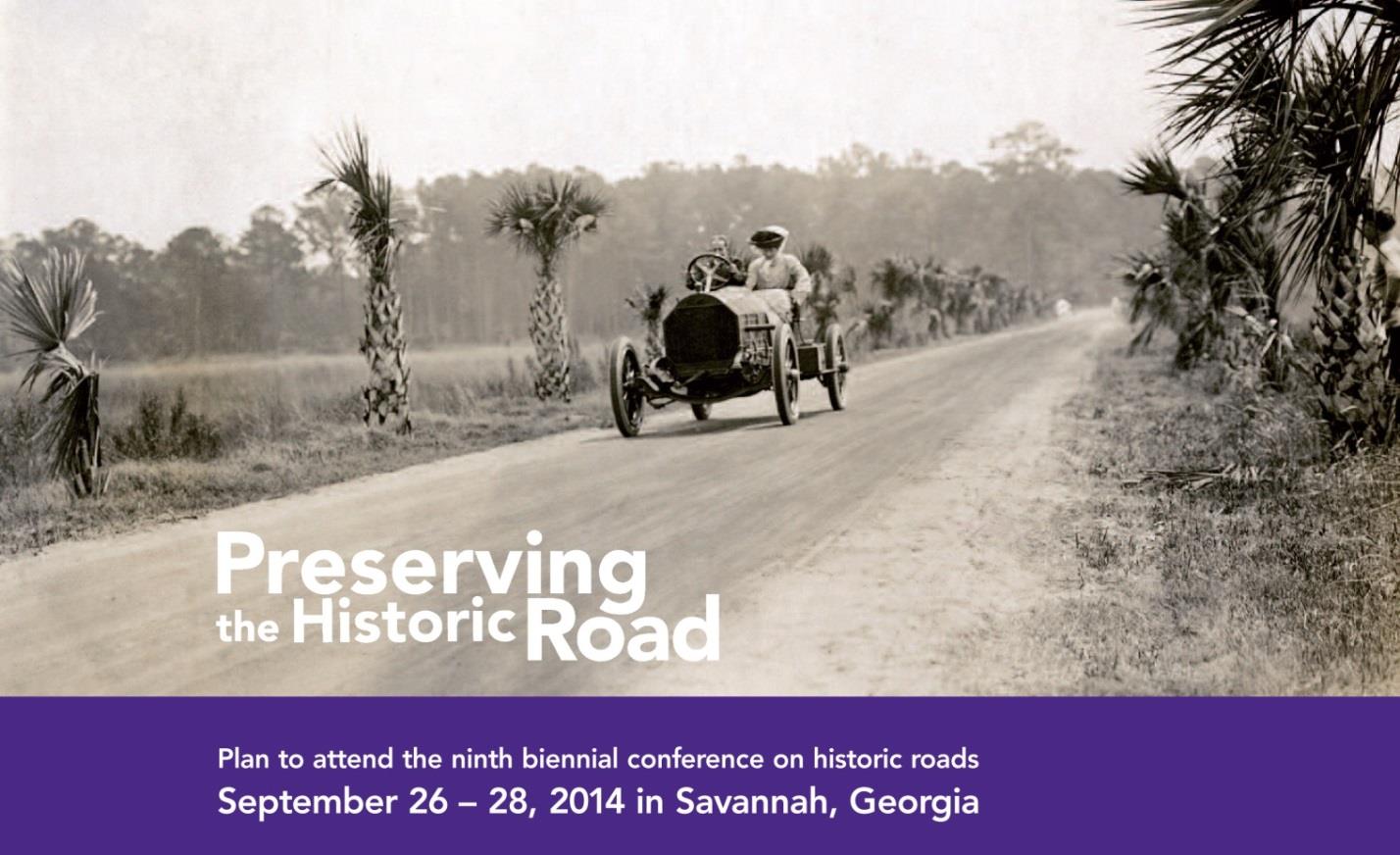2022 Preserving the Historic Road International
Mitchell Point Tunnel (Photo: Oregon Department of Transportation)
Advocacy to Action: Meeting the Challenges of the Next Generation
Online REGISTRATION CLOSES Friday 16 September at 7.00pm US Eastern / 4.00pm US Pacific. On-site registration will be available during the conference for an additional fee.
Join us in Portland, Oregon September 22-24, 2022 for Preserving the Historic Road International. We welcome you back after four years of planning (and pandemic) to a new conference, with a dynamic new format, designed to meet the challenges for historic roads in the coming decades. The NEW PHRI will engage you in direct conversations with experts, put you in the field with some of America’s greatest roads and invite you to reimagine how we identify, preserve and manage the next generation of historic roads.
Our group rate for The Nines Hotel is now closed. For hotel information, please visit https://www.thenines.com/.
As we are making plans for PHRI 2022 in Portland, we are cognizant of the ongoing pandemic. Please know that we will follow all CDC, state and local recommendations regarding COVID and make adjustments to our program, as needed. Your safety is our highest priority.
DO YOUR HOMEWORK! FREE online Training from the National Preservation Institute.
To help you prepare for Portland, the National Preservation Institute (NPI) is offering all PHRI 2022 registered conference attendees a FREE NPI online training course! A leader in preservation and heritage education, NPI offers online, on-demand courses, webinars, and in-person training, with topics ranging from Section 106 basics to historic roads. In addition, all PHRI conference attendees will be offered a 20% discount on a future online training of their choice.
- Select your free training before the Portland conference (offer expires on 25 September 2022).
CHOOSE FROM:
-Cultural Landscapes: An Overview, Nancy J. Brown, FASLA, instructor
-Streetscape Design: Strategies for Historic Districts, Paul Daniel Marriott, instructor
- After the PHRI conference, NPI is offering all registered attendees a 20% discount on a single online training. Attendees may select from any of the online trainings listed in the NPI catalog. (Offer expires on 25 October 2022—you will have access to the training for one year from time of purchase).
- To learn more about NPI online trainings, please visit: https://www.npi.org/trainings
TO REGISTER FOR YOUR FREE OR DISCOUNTED NPI COURSE: Contact Jere Gibber, 703.765.0100, info@npi.org
*Please note that Paul Daniel Marriott has waived his instructor fee for anyone selecting the free or 20% discount for ‘Streetscape Design’ training within the relevant dates.
LABORATORY ROADS – Lessons from Portland

Looking toward downtown Portland from Terwilliger Parkway, 1912. Courtesy: Friends of Terwilliger Parkway

NE Union Avenue (now NE MLK Jr. Boulevard), 1929. Courtesy: City of Portland Archives
HANDS-ON AND IN THE FIELD!
With our new conference format this September, we will focus on two Portland ‘laboratory’ roads that represent both established and emerging historic road typologies—Terwilliger Parkway and Martin Luther King Jr. Boulevard.
Join us the afternoon of the first day of the conference when we take you to explore these two historic roads for hands-on and on-site conversations with local advocates and national experts. You’ll learn cutting edge strategies for the identification, preservation and management of historic roads. While we study these historic corridors, we’ll ask you to share your own historic road questions and accomplishments as we debate global ideas and options for success on the road in our host city.
Here’s a sneak peek at what you’ll learn while visiting our two National Register recognized corridors:
Terwilliger Parkway (SW Terwilliger Boulevard) is an Olmsted legacy road and fine example of an established historic road. It was listed in the National Register in 2021 as an example of a linear parkway corridor. Designed by John Charles Olmsted, and dedicated in 1914, the serpentine route designed for pleasure driving gently follows the city’s natural topography, beneath a forest canopy. It is a part of the larger Olmsted Brothers plan for regional parkways and trails in Portland. This historic corridor encompasses issues of visitor management, safety, landscape management, conservation, and heritage policy in a classic parkway corridor.
Martin Luther King Jr. Boulevard is an exceptional example of an emerging historic road. It is part of the 2020 National Register Multiple Property Designation (MPD) “African American Resources in Portland, Oregon, 1851-1973.” This historic road, originally established in the nineteenth century as Union Avenue, was designated as part of US Route 99 in the 1920s and renamed NE Martin Luther King Jr. Boulevard in 1989. This corridor, the historic heart of Portland’s Black community, encompasses issues of cultural identity, gentrification, economic development and historic design responses to a road that has evolved significantly over its history.
What to know more? Visit to learn about our laboratory roads:
THANK YOU!
Preserving the Historic Road International extends a grateful thank you to the following organizations:
PARTNERS
AASHTO
AASHTO – The American Association of State Highway and Transportation Officials – is a nonprofit, nonpartisan association representing highway and transportation departments in the 50 states, the District of Columbia, and Puerto Rico. It represents all transportation modes, including air, highways, public transportation, active transportation, rail, and water. Its primary goal is to foster the development, operation, and maintenance of an integrated national transportation system. AASHTO works to educate the public and key decision-makers about the critical role that transportation plays in securing a good quality of life and sound economy for our nation. AASHTO serves as a liaison between state departments of transportation and the Federal government. AASHTO is an international leader in setting technical standards for all phases of highway system development. Standards are issued for design, construction of highways and bridges, materials, and many other technical areas.
VISIT: https://www.transportation.org/
Federal Highway Administration
The Federal Highway Administration (FHWA) provides stewardship over the construction, maintenance and preservation of the Nation’s highways, bridges and tunnels. FHWA also conducts research and provides technical assistance to state and local agencies to improve safety, mobility, and to encourage innovation.
VISIT: https://highways.dot.gov/
National Park Service: Historic American Engineering Record
In 1969, the National Park Service, the American Society of Civil Engineers, and the Library of Congress established the Historic American Engineering Record (HAER) to create a permanent documentary record of the nation’s engineering and industrial legacy. Now over fifty, HAER is part of the NPS Heritage Documentation Programs (HDP), along with HABS (Historic American Buildings Survey), and HALS (Historic American Landscapes Survey). Recent large-scale projects include: National Park Roads and Bridges Project, National Covered Bridges Recording Project, and the Hagerty Drivers Foundation Project to create a comprehensive record of the most historically significant vehicles in the US. Recently, Justine Christianson and Christopher Marston coedited the “HAER at 50” theme issue of the IA: The Journal of the Society for Industrial Archeology
VISIT: www.nps.gov/hdp/haer/index.htm
Paul Daniel Marriott + Associates
Paul Daniel Marriott + Associates specializes in consulting for sites and projects at the intersection of landscape, preservation, transportation and planning. The firm is nationally recognized for its work with the identification, preservation and management of historic and scenic roads, the protection of historic and cultural landscapes, the preparation of local, state, tribal and federal policy to protect historic places, and work with advocacy organizations and institutions dedicated to the preservation of special places.
VISIT: www.pauldanielmarriott.com
SRI Foundation
The SRI Foundation seeks to enrich society by fostering Historic Preservation. The Foundation achieves this mission by creating an understanding and appreciation of our shared past and by improving the practice of Historic Preservation.
VISIT: www.srifoundation.org
PHRI 2022 LEAD SPONSOR
Oregon Department of Transportation
ODOT provides a safe and reliable multimodal transportation system that connects people and helps Oregon’s communities and economy thrive.
VISIT: www.oregon.gov/odot/Pages/index.aspx
SPONSORS
Archaeological Investigations Northwest, Inc.
Archaeological Investigations Northwest, Inc. (AINW), provides the full spectrum of cultural resource consulting services to both public and private sector clients in the Pacific Northwest. For more than three decades, AINW has conducted approximately 3,000 cultural resource projects that encompass the breadth of cultural resource disciplines: archaeology, architectural history, history, and ethnography. Most of these projects have been done to meet the compliance regulations of Section 106 of the National Historic Preservation Act and documentation for Environmental Assessments (EA) and Environmental Impact Statements (EIS), and for local and state agency review of development and energy projects.
VISIT: http://www.ainw.com
David Evans and Associates
At DEA, we are creating a different future: Engineers, surveyors, planners, hydrographers, landscape architects, and natural resources scientists working together to improve the quality of life while demonstrating stewardship of the built and natural environments. DEA’s philosophy, core purpose, vision, and values strike a balance between freedom and responsibility, guidance and accountability, and economic progress and environmental stewardship.
VISIT: https://www.deainc.com/
Mead and Hunt
Mead & Hunt provides cultural resource management and historic preservation services nationwide to identify efficient and innovative solutions that balance project goals and regulatory requirements.
VISIT: www.meadhunt.com
National Preservation Institute
The National Preservation Institute (NPI) offers continuing education and professional training for those involved in the management, preservation, and stewardship of cultural heritage. NPI serves a broad spectrum from the government and private sectors by providing training in historic preservation and cultural resource management.
VISIT: www.npi.org
Pennsylvania State University: Landscape Architecture Program
The Department of Landscape Architecture within the Stuckeman School operates with a bold mission: Inspired work grounded in commitment to environmental and social good. Penn State Landscape Architecture is recognized for student-centric educational excellence and innovative research. Faculty represent a full range of interests from scientific to artistic and humanistic views of the world. Design starts from day one, and in all programs – both undergraduate and graduate – students gain the skills and know-how to tackle design problems in our increasingly complex world.
VISIT: https://arts.psu.edu/academics/department-of-landscape-architecture/
University of Oregon: Historic Preservation Program
The School of Architecture & Environment’s Historic Preservation program—the oldest such program on the West Coast—operates out of the University of Oregon’s Portland campus, where students can study the city’s rich physical and social heritage and participate in the dynamic planning processes that are shaping this center of urban sustainability. Students take classes in the White Stag Building, an award-winning adaptive reuse of several historic commercial buildings, and apply the skills they learn in real-world projects that help communities understand and protect their cultural resources and traditions.
Risks to Historic Roads – Pre-Conference Findings, November 2021
HISTORIC ROAD CATEGORIES AND RISKS TO HISTORIC ROADS FROM THE PRESERVING THE HISTORIC ROAD INTERNATIONAL
PRE-CONFERENCE ONLINE SESSION, 10 NOVEMBER 2021
The following document presents the results of discussions held on November 10, 2021 during the Preserving the Historic Road International (PHRI) Pre-Conference Online Session, identifying an initial list of high priority historic roads and the risks associated with these roads. This initial list of high priority roads and risks will be the focus of the 2022 PHRI Conference in Portland, Oregon, September 22-24, 2022.
Welcome to the Preserving the Historic Road International Conference.
We are the leading global forum addressing the identification, preservation and management of historic roads.
Conference History
Preserving the Historic Road International Conference (PTHRIC) began in 1995 as a regional historic roads conference in White Plains, New York, alongside the historic Bronx River Parkway. This initial gathering, focusing on historic parkways in the Northeast, established the need for a larger and national dialogue—how to accomplish such a mission was still unclear.
In 1997 a Cultural Resources Training Initiative grant from the National Park Service and staff support from the National Trust for Historic Preservation and the California Department of Transportation provided the catalyst needed to consider a national conference. The first planning meeting was held at a restaurant on the historic Plaza in Santa Fe, New Mexico during the 1997 National Preservation Conference. The first national gathering to discuss historic roads was planned for the following spring of 1998—Preserving the Historic Road in America, as the conference was first titled, was born.
The mission established for the first conference was to bring together different viewpoints from different perspectives regarding the identification, preservation and management of historic roads in the United States. Founded during a period when many signature historic roads, such as the Bronx River Parkway (New York), were facing imminent threats for destruction and demolition stemming from safety and liability concerns, the conference organized around the idea of bringing engineers and preservationists—often in adversarial relationships—together for frank conversations and information sharing. Despite the pressures facing many historic roads, this was also a time during which some of the first comprehensive historic road inventories and progressive state transportation policies were being developed—most notably for the Historic Columbia River Highway (Oregon) and the Merritt Parkway (Connecticut).
From the beginning, the conference sought participation in each host state from both the state transportation department and the state historic preservation office. This unusual partnership—strategic, imaginative and symbolic—earned the conference immediate credibility and was soon mirrored by national-level sponsors from the federal government and advocacy organizations. Long term national sponsors include: the National Park Service (NPS), an ongoing sponsor since the first conference in Los Angeles in 1998, the Federal Highway Administration (FHWA), an ongoing sponsor since the second conference in Morristown, New Jersey in 2000, and the American Association of State Highway and Transportation Officials (AASHTO), an ongoing sponsor since the third conference in Omaha in 2002. Regular sponsors and participants have included: the Bureau of Land Management (BLM), US Forest Service (USFS), State Departments of Transportation (DOT), State Historic Preservation Offices (SHPO), Tribal Departments of Transportation (DOT), Tribal Preservation Offices (THPO), Transportation Research Board (TRB), National Transportation Safety Board (NTSB), National Preservation Institute (NPI) and the National Trust for Historic Preservation. In addition, numerous local and regional historic road advocacy organizations and academic institutions have helped to sponsor the conference.
Preserving the Historic Road in America created an environment where issues of highway safety and function could be addressed within the context of a historic road facility. Given the tensions surrounding the topic of historic roads, particularly in the early years, the conference consciously established an environment that would be viewed as objective, neutral and diverse. While the initial purpose behind the conference was halting further losses to the nation’s historic roads, it quickly became a forum for sharing innovations and advancements in technology, research, engineering and historic preservation. After the 2004 conference, the name was changed from Preserving the Historic Road in America to Preserving the Historic Road due to increasing participation by attendees outside the US. As the conference matured, it became an international forum for historic roads. In 2018, the twentieth anniversary of the conference, the name was changed to Preserving the Historic Road International Conference.
Since the founding, Preserving the Historic Road has striven to create an environment that is enjoyable, collegial, intelligent and purposeful. As a result, transportation departments have become better stewards of historic roads, and preservationists have become better advocates for flexible design policies that recognize safety and function. The conference has a proud legacy of education and awareness that has significantly advanced the identification, preservation and management of historic roads in the United States and around the globe.
Past Conferences & Proceedings
Past Conferences
- Los Angeles, California, 1998
- Morristown, New Jersey, 2000
- Omaha, Nebraska, 2002
- Portland, Oregon, 2004
- Boston, Massachusetts, 2006
- Albuquerque, New Mexico, 2008
View the French perspective on the 2008 conference - Washington, DC, 2010
View the 2010 conference program - Indianapolis, Indiana, 2012
View the 2012 conference program - Savannah, Georgia, 2014
View the 2014 conference program - [No conference, 2016]
- Fort Collins, Colorado, 2018
Proceedings
Since the first conference in 1998, academic and professional papers have been collected and assembled as the official proceedings of the conference. The PTHRIC Proceedings represent one of the largest collections of historic roads research in the world.
- Los Angeles Proceedings, 1998
- Morristown Proceedings, 2000
- Omaha Proceedings, 2002
- Portland Proceedings, 2004
- Boston Proceedings, 2006
- Albuquerque Proceedings, 2008
- Washington, DC Proceedings, 2010
- Indianapolis Proceedings, 2012
- Savannah Proceedings, 2014
- [No conference, 2016]
- Fort Collins Proceedings, 2018
Arroyo Seco Parkway, c. 1940, Los Angeles, California. Credit: California Department of Transportation



